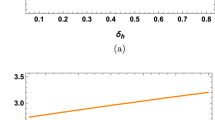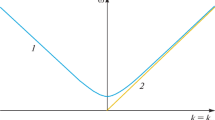Abstract
Flow pulsations in two-phase and single-phase near-critical fluids are considered as a possible source of ultra-low-frequency seismo-electromagnetic variations. The conditions for generation and suppression of density wave instability in the crust are analyzed and the surface electromagnetic effect due to streaming potential generation is estimated. The upper limit of amplitude of magnetic field variations due to density wave instability is about 0.1 nT for single-phase supercritical and 1 nT for two-phase flow oscillations in the frequency range \(10^{-4}{-}10^{-2}~\) Hz for the temperature gradients and spatial scales possible during strike slip events. The signal is characterized by a decaying amplitude with typical relaxation time of about several quasi-periods. The possibility of generation of very low-frequency flow pulsations in two-phase fluids via individual bubble evolution and interaction with external acoustic waves is discussed.


Similar content being viewed by others
References
Antraygues P, Aubert M (1993) Self potential generated by two-phase flow in a porous medium: experimental study and volcanological applications. J Geophys Res 98B:22273–22281
Baehr HD (1973) Termodynamik. Springer, Berlin, p 518
Borisov AA, Gel’fand BE, Nigmatulin RI (1982) Amplification of shock waves in liquids with bubbles of vapor and solutable gas. Dokl Akad Nauk USSR 263:594–598
Boure JA, Bergles AE, Tong LS (1973) Review of two-phase flow instability. Nucl Eng Des 25:165–192
Bowers TS, Helgeson HC (1983) Calculation of the thermodynamic and geochemical consequences of non-ideal mixing in the system \({\text{ H }}_2\)O-\({\text{ CO }}_2\)-NaCl on phase relations in geologic systems: equation of state for \({\text{ H }}_2\)O-\({\text{ CO }}_2\)-NaCl fluids at high pressures and temperatures. Geochim Cosmochim Acta 47:1247–1275
Brown S, Caprihan A, Hardy R (1998) Experimental observation of fluid flow channels in a single fracture. J Geophys Res 103(B3):5125–5132. https://doi.org/10.1029/97JB03542
Brudzinski MR, Hinojosa-Prieto HR, Schlanser KM, Cabral-Cano E, Arciniega-Ceballos A, Diaz-Molina O, DeMets C (2010) Nonvolcanic tremor along the Oaxaca segment of the Middle America subduction zone. J Geophys Res 115:B00A23. https://doi.org/10.1029/2008JB006061
Daney DE, Ludtke PR, Jones MC (1979) An experimental study of thermally-induced flow oscillations in super-critical helium. J Heat Transf Trans ASME 101:9–14
Delhaye JM, Giot M, Riethmuller ML (1981) Thermohydraulics of two-phase systems for industrial design and nuclear engineering. Hemisphere Publication Corp., New York
Draganov AB, Inan US, Taranenko YuN (1991) ULF magnetic signatures at the earth surface due to ground water flow: a possible precursor to earthquakes. Geophys Res Lett 18:1127–1130
Duan ZH, Moller N, Weare JH (1995) Equation of state for the NaCl-\({\text{ H }}_2\)O-\({\text{ CO }}_2\) system: prediction of phase equilibria and volumetric properties. Geochim Cosmochim Acta 59:2869–2882
Fedorov EN, Pilipenko VA, Uyeda S (2001) Electric and magnetic fields generated by electrokinetic processes in a conductive crust. Phys Chem Earth 26(10–12):793–799
Fitterman DV (1979) Theory of electrokinetic-magnetic anomalies in a faulted half-space. J Geophys Res 84B:6031–6040
Fitterman DV (1978) Electrokinetic and magnetic anomalies associated with dilatant regions in a layered earth. J Geophys Res 83B:5923–5928
Fenoglio MA, Johnston MJS, Byerlee JD (1995) Magnetic and electric-fields associated with changes in high pore pressure in fault zones: application to the Loma–Prieta ULF emissions. J Geophys Res 100B:12951–12958
Fletcher JB, Baker LM (2010) Analysis of nonvolcanic tremor on the San Andreas fault near Parkfield, CA using U. S. Geological Survey Parkfield Seismic Array. J Geophys Res 115:B10305. https://doi.org/10.1029/2010JB007511
Fraser-Smith AC, Bernardi A, McGill PR, Bowen MM, Ladd ME, Helliwell RA, Villard OG Jr (1990) Low-frequency magnetic field measurements near the epicenter of the Ms = 7.1 Loma Prieta earthquake. Geophys Res Lett 17:1465–1468
Fujita E, Araki K (2011) Nagano K Volcanic tremor induced by gas-liquid two-phase flow: implications of density wave oscillation. J Geophys Res 116:B09201. https://doi.org/10.1029/2010JB008068
Hammit FG (1980) Cavitation and multiphase flow phenomena. McGraw-Hill Inc., New York
Hayakawa M, Kawate R, Molchanov OA, Yumoto K (1996) Results of ultra-low-frequency magnetic field measurements during the Guam earthquake of 8 August 1993. Geophys Res Lett 23:241244
Hayakawa M, Schekotov A, Fedorov E, Hobara Y (2013) On the ultra-low-frequency magnetic field depression for three huge oceanic earthquakes in Japan and in the Kurile Islands. Earth Sci Res 2. https://doi.org/10.5539/esr.v2n1p33
Ishido T, Mitsutani H (1981) Experimental and theoretical basis of electrokinetic phenomena in rock-water systems and its application to geophysics. J Geophys Res 86B:1763–1775
Jain KC, Petrick M, Miller D, Bankoff SG (1966) Self sustained hydrodynamic oscillations in natural-circulation boiling water loop. Nucl Eng Des 4:233–252
Johnson MJS, Byerlee JD, Lockner D (2001) Rapid fluid disruption: a source for self-potential anomalies on volcanos. J Geophys Res 106B:4327–4335
Kakac S, Liu H (1991) Two-phase flow dynamic instabilities in boiling systems. In: Chen XJ, Veziroglu TN, Tien CL (eds) Multiphase flow and heat transfer, vol 1, pp 403–444
Kedar S, Kanamori H, Sturtevant B (1998) Bubble collapse as the source of tremor at Old-Faithful Geyser. J Geophys Res. 103B:24283–24299
Kedar S, Sturtevant B, Kanamori H (1996) The origin of harmonic tremor of Old-Faithful Geyser. Nature 379:708–711
Kopytenko YuA, Matiashvili TG, Voronov PM, Kopytenko EA, Molchanov OA (1993) Detection of ULF emissions connected with the Spitak earthquake and its aftershock activity, based on geomagnetic pulsation data at Dusheti and Vardzia observatories. Phys Earth Planet Inter 77:85–95
Labuntsov DA, Mirzoyan PA (1983) Stability boundary analysis for super-critical helium flowing in heated channels. Teploenerg 3:2–4
Lachenbruch AH (1980) Frictional heating, fluid pressure and the resistance to fault motion. J Geophys Res 85B:6097–6112
Lane SJ, Chouet BA, Phillips JS, Dawson P, Ryan DA, Hurst E (2001) Experimental observations of pressure oscillations and flow regimes in analogue volcanic system. J Geophys Res 106B:6461–6476
Lee TC (1996) Pore pressure rise, frictional strength, and fault slip: one-dimensional interaction models. Geophys J Int 125:371–384
Lee TC, Delaney PT (1987) Frictional heating and pore pressure rise due to a fault slip. Geophys J R Astron Soc 88:569–591
Leet RC (1988) Saturated and sub-cooled hydrothermal boiling in groundwater flow channels as a source of harmonic tremor. J Geophys Res 93B:4835–4849
Lockner DA, Johnston MJS, Byerlee J (1983) A mechanism to explain the generation of earthquake lights. Nature 302:28–33
Mader HM, Brodsky E, Howard D, Sturtevant B (1997) Laboratory simulations of sustained volcanic eruptions. Nature 388:362–364
Molchanov O, Schekotov A, Fedorov E, Belyaev G, Gordeev E (2003) Preseismic ULF electromagnetic effect from observation at Kamchatka. Nat Hazard Earth Syst Sci 3:17
Molchanov O, Hayakawa M (2008) Seismo electromagnetics and related phenomena: history and latest results. TERRAPUB, Tokyo, p 189
Morgan FD, Williams ER, Madden TR (1989) Streaming potential properties of Westerly granite with applications. J Geophys Res 94B:12449–12461
Nigmatulin R (1987) Dynamics of multiphase systems. Nauka, Moscow (in Russian)
Roeloffs EA (1988) Fault stability changes induced beneath a reservoir with cyclic variations in water level. J Geophys Res 93B:2107
Schekotov A, Molchanov O, Hattori K, Fedorov E, Gladyshev VA, Belyaev GG, Chebrov V, Sinitsin V, Gordeev E, Hayakawa M (2006) Seismo-ionospheric depression of the ULF geomagnetic fluctuations at Kamchatka and Japan. Phys Chem Earth 31(4–9):313–318
Surkov V, Hayakawa M (2014) Ultra and extremely low frequency electromagnetic fields. Springer, Tokyo, p 486
Surkov V, Pilipenko V (1999) The physics of pre-seismic electromagnetic ULF signals. In: Hayakawa M (ed) Atmospheric and ionospheric electromagnetic phenomena associated with earthquakes, pp 357–370, TERRAPUB, Tokyo
Watson EB, Brenan JM (1987) Fluids in lithosphere 1. Experimentally determined wetting characteristics of \({\text{ CO }}_2\)-\({\text{ H }}_2\)O fluids and their implications for fluid transport, host rock physical properties and fluid inclusion formation. Earth Planet Sci Lett 85:497–515
Watt AD (1967) VLF radio-engineering. Pergamon Press, Oxford, p 704
Yadigaroglu G, Bergles AE (1972) Fundamental and higher mode density wave oscillations in two phase flow. J Heat Transf Trans ASME 94:189–195
Zuber N, Staub FW (1966) The propagation and the wave form of the vapor volumetric concentration in boiling, forced convection system under oscillatory conditions. Int J Heat Mass Transf 9:871–895
Acknowledgements
The authors are grateful to Prof. S. Uyeda for helpful discussions and the interest to the problem. This work is supported by the RFBR grant 15-55-45064.
Author information
Authors and Affiliations
Corresponding author
Rights and permissions
About this article
Cite this article
Yagova, N.V., Yagov, V.V., Sinha, A.K. et al. Flow instabilities in two-phase or supercritical crust fluids and its possible relevance to seismo-electromagnetic disturbances. Nat Hazards 92, 369–379 (2018). https://doi.org/10.1007/s11069-018-3203-5
Received:
Accepted:
Published:
Issue Date:
DOI: https://doi.org/10.1007/s11069-018-3203-5




